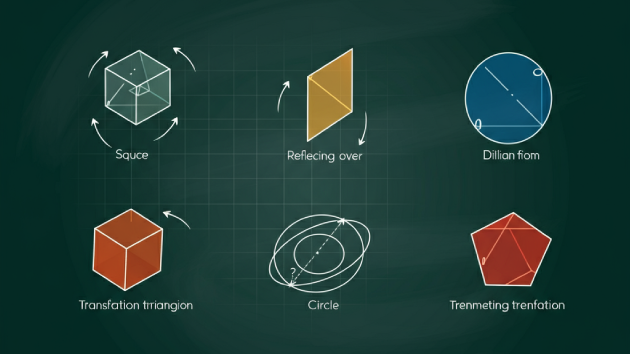



Geometry is all around us—you can see it in the wings of a butterfly or the way a bicycle wheel turns. Many of these patterns and movements are examples of geometric transformations.
Learning about these transformations helps students understand how shapes move, change, and fit together. In this post, we’ll introduce you to the basics of geometric transformations, explore the different types, explain their key properties, and show how they are used in everyday life.
By the end, you'll have a better understanding of both the math and the world around you!
A geometric transformation is a way to change a shape by moving it, resizing it, or turning it. In simple terms, it's how a shape changes to create a new version called the image, while the original shape is known as the pre-image.
Understanding these basics is the first step toward mastering the different forms of geometric transformations.
Geometric transformations can be categorized based on how they move or alter a figure. Below, we’ll explore the four primary types with definitions, features, and examples.
Translation involves sliding a geometric figure from one position to another without changing its size, shape, or orientation. To perform a translation, each point of the shape moves the same distance in the same direction.
Consider a triangle with vertices at (1,2), (3,4), and (5,2). If we apply a translation of (x+3, y+2), the new vertices will be at (4,4), (6,6), and (8,4). The triangle retains its original size and orientation but shifts position on the coordinate plane.
Reflection creates a mirror image of a shape by flipping it across a specific line, known as the "line of reflection."
If a rectangle sits on the x-axis and we reflect it across the y-axis, the rectangle flips horizontally while maintaining its same dimensions and area.
Rotation turns a figure around a fixed point, known as the center of rotation. The degrees of rotation (e.g., 90°, 180°) determine how far the shape rotates, and it can rotate clockwise or counterclockwise.
Picture a square rotated 90° counterclockwise around its center. The result is a new orientation, but the size and relative placement of its sides remain unchanged.
Dilation is different from other transformations like sliding, flipping, or turning a shape (called rigid transformations). Instead of just moving the shape, dilation changes its size—it can make the shape bigger or smaller while keeping the same shape. This change depends on a special point called the center and a number called the scale factor.
Suppose a triangle is dilated by a scale factor of 2 from the origin. The resulting triangle is twice as large in all dimensions but identical in proportionality.
It’s crucial to understand the distinction between these two transformation types:
Rigid transformations are ideal when the goal is movement or repositioning, while dilation is essential for resizing objects.
Geometric transformations aren’t limited to the classroom; they’re tools you can spot in daily life and in various industries.
From drafting blueprints to creating decorative tessellations, architects use transformations to design proportional and symmetrical buildings. Reflection symmetry is often employed in designing facades.
Animators rely on transformations during motion graphics and character movements. For example, rotating and translating shapes helps create the illusion of motion.
When resizing an image in apps like Photoshop, dilation ensures that proportions remain intact. Similarly, augmented reality apps use transformations to align 3D models with the real world.
Rotation and translation are commonplace in mapping. For instance, GPS systems use these transformations to guide vehicles from one point to another accurately.
Robots rely on transformations for spatial orientation, ensuring they can move and interact with objects efficiently.
Geometric transformations help make math more visual, fun, and connected to the real world. When students understand how each type of transformation works, they can solve harder math problems with more confidence and start seeing geometry in the world around them.
If you want to learn more or try it out for yourself, you can work with a tutor or use fun, interactive tools online. You’ll be surprised at how much easier—and more exciting—math becomes when you start seeing it everywhere in your life!